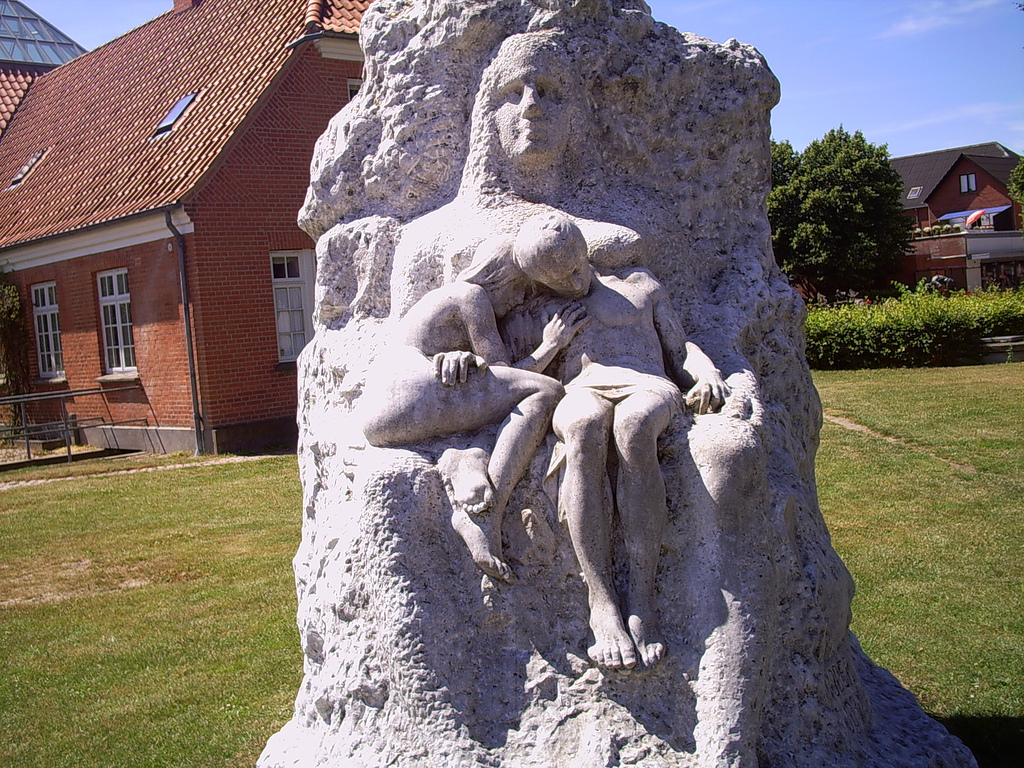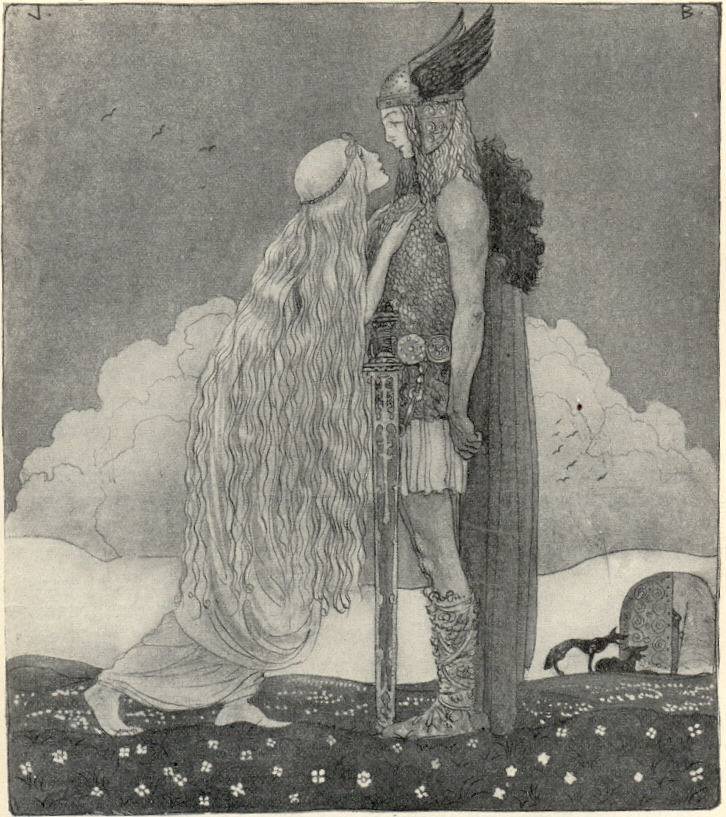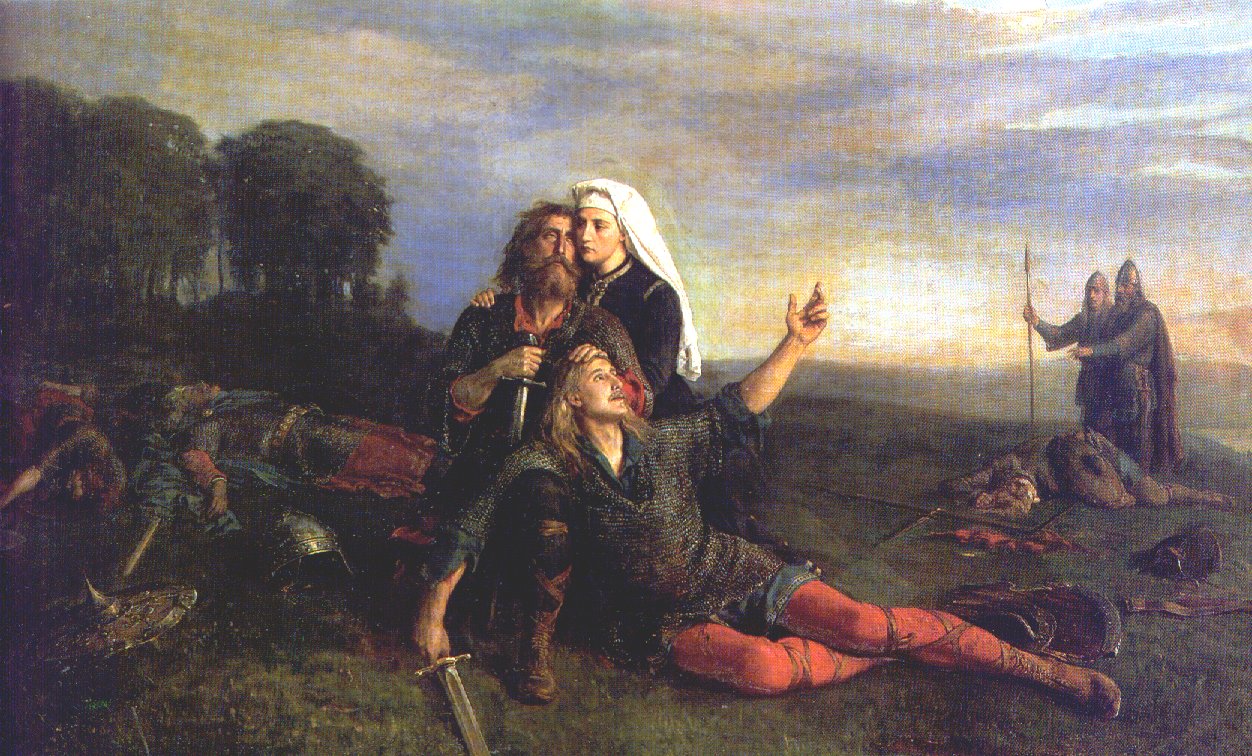|
Dellingr
In Norse mythology, Dellingr (Old Norse possibly "the dayspring"Bellows (1936:75). or "shining one"Orchard (1997:32).) is a god. Dellingr is attested in the ''Poetic Edda'', compiled in the 13th century from earlier traditional sources, and in the ''Prose Edda'', written in the 13th century by Snorri Sturluson. In both sources, Dellingr is described as the father of Dagr, the personified day. The ''Prose Edda'' adds that, depending on manuscript variation, he is either the third husband of Nótt, the personified night, or the husband of Jörð, the personified earth. Dellingr is also attested in the legendary saga '' Hervarar saga ok Heiðreks''. Scholars have proposed that Dellingr is the personified dawn and his name may appear both in an English surname and place name. Attestations ''Poetic Edda'' Dellingr is referenced in the ''Poetic Edda'' poems ''Vafþrúðnismál'' and ''Hávamál''. In stanza 24 of ''Vafþrúðnismá'', the god Odin (disguised as " Gagnráðr") asks the j ... [...More Info...] [...Related Items...] OR: [Wikipedia] [Google] [Baidu] |
Dagr
Dagr (Old Norse: , "day")Lindow (2001:91). is the divine personification of the day in Norse mythology. He appears in the ''Poetic Edda'', compiled in the 13th century from earlier traditional sources, and the ''Prose Edda'', written in the 13th century by Snorri Sturluson. In both sources, Dagr is stated to be the son of the god Dellingr and is associated with the bright-maned horse Skinfaxi, who "draw day to mankind". Depending on manuscript variation, the ''Prose Edda'' adds that Dagr is either Dellingr's son by Nótt, the personified night, or Jörð, the personified Earth. Otherwise, Dagr appears as a common noun simply meaning "day" throughout Old Norse works. Connections have been proposed between Dagr and other similarly named figures in Germanic mythology. Eddaic Dagr ''Poetic Edda'' Dagr is mentioned in stanzas 12 and 25 of the poem ''Vafþrúðnismál''. In stanza 24, the god Odin (disguised as " Gagnráðr") asks the jötunn Vafþrúðnir from where the day comes, a ... [...More Info...] [...Related Items...] OR: [Wikipedia] [Google] [Baidu] |
Nótt
In Norse mythology, Nótt (Old Norse: , "night"Orchard (1997:120).) is night personified. In both the ''Poetic Edda'', compiled in the 13th century from earlier traditional sources, and the ''Prose Edda'', composed in the 13th century, Nótt is listed as the daughter of a figure by the name of Nörvi (with variant spellings) and is associated with the horse Hrímfaxi, while the ''Prose Edda'' features information about Nótt's ancestry, including her three marriages. Nótt's third marriage was to the god Dellingr and this resulted in their son Dagr, the personified day (although some manuscript variations list Jörð as Dellingr's wife and Dagr's mother instead). As a proper noun, the word ''nótt'' appears throughout Old Norse literature. Attestations ''Poetic Edda'' In stanza 24 of the poem ''Vafþrúðnismál'', the god Odin (disguised as " Gagnráðr") asks the jötunn Vafþrúðnir from where the day comes, and the night and its tides. In stanza 25, Vafþrúðnir responds: ... [...More Info...] [...Related Items...] OR: [Wikipedia] [Google] [Baidu] |
Jörð
Jörð ( non, Jǫrð, lit=earth) is the personification of earth and a goddess in Norse mythology. She is the mother of the thunder god Thor and a sexual partner of Odin. Jörð is attested in Danish historian ''Gesta Danorum'', composed in the 12th century by Danish historian Saxo Grammaticus; the ''Poetic Edda'', compiled in the 13th century by an unknown individual or individuals; and the ''Prose Edda'', also composed in the 13th century. Her name is often employed in skaldic poetry and kennings as a poetic term for land or earth. Name Etymology Old Norse means 'earth, land', serving both as a common noun ('earth') and as a theonymic incarnation of the noun ('Earth-goddess'). It stems from Proto-Germanic ''*erþō''- ('earth, soil, land'), as evidenced by the Gothic , Old English , Old Saxon , or Old High German (OHG) . The Ancient Greek word (; 'earth') is also possibly related. The word is most likely cognate with Proto-Germanic ''*erwa'' or ''erwōn-'', meaning ... [...More Info...] [...Related Items...] OR: [Wikipedia] [Google] [Baidu] |
Norse Dwarves
A dwarf () is a type of supernatural being in Germanic folklore, including mythology. Accounts of dwarfs vary significantly throughout history however they are commonly, but not exclusively, presented as living in mountains or stones and being skilled craftsmen. In early literary sources, only males are explicitly referred to as dwarfs, although they are described as having sisters and daughters, while both male and female dwarfs feature in later saga literature and folklore. Dwarfs are sometimes described as short, however, scholars have noted that this is neither explicit nor of relevance to their roles in the earliest sources. Dwarfs continue to feature in modern popular culture such as in the works of J.R.R. Tolkien and Terry Pratchett, where they are often, but not exclusively, presented as distinct from elves. Etymology The modern English noun ''dwarf'' descends from ang, dweorg. It has a variety of cognates in other Germanic languages, including non, dvergr and goh, tw ... [...More Info...] [...Related Items...] OR: [Wikipedia] [Google] [Baidu] |
Vafþrúðnir
Vafþrúðnir (Old Norse: ; "mighty weaver"Orchard (1997:170).) is a wise jötunn in Norse mythology. His name comes from ''Vaf'', which means weave or entangle, and ''thrudnir'', which means strong or mighty. Some interpret it to mean "mighty in riddles". Du Chaillu, P. B. (1889). It may be anglicized Vafthruthnir or Vafthrudnir. In the Poetic Edda poem ''Vafþrúðnismál'', Vafþrúðnir acts as (the disguised) Odin's host and opponent in a deadly battle of wits that results in Vafþrúðnir's defeat. Characterization A small portion of Poetic Edda provides some context and description of Vafthrudnir. While contemplating his visit to the giant, Odin's wife Frigg offers a warning for him to be wary of this particular giant because, "Amid all the giants an equal in might, To Vafthruthnir know I none."Vafþrúðnismál, tr. Henry Adams Bellows, at Wikisource At this point however Odin has already insisted, And Vafthruthnir fain would find; fit wisdom old with the giant wise My ... [...More Info...] [...Related Items...] OR: [Wikipedia] [Google] [Baidu] |
Gylfaginning
''Gylfaginning'' (Old Norse: 'The Beguiling of Gylfi' or 'The Deluding of Gylfi'; c. 20,000 words; 13th century Old Norse pronunciation ) is the first part of the 13th century ''Prose Edda'' after the Prologue. The ''Gylfaginning'' deals with the creation and destruction of the world of the Æsir and many other aspects of Norse mythology. The second part of the Prose Edda is called the ''Skáldskaparmál'' and the third '' Háttatal''. Summary The ''Gylfaginning'' tells the story of Gylfi, a king of "the land that men now call Sweden", who, after being tricked by one of the goddesses of the Æsir, wonders if all Æsir use magic and tricks for their will to be done. This is why he journeys to Asgard, but on the way he is tricked by the gods and arrives in some other place, where he finds a great palace. Inside the palace he encounters a man who asks Gylfi's name and so King Gylfi introduces himself as Gangleri. Gangleri then is taken to the king of the palace and comes upon thre ... [...More Info...] [...Related Items...] OR: [Wikipedia] [Google] [Baidu] |
Fjölsvinnsmál
''Fjölsvinnsmál'' (Old Norse: 'The Lay of Fjölsvinn') is the second of two Old Norse poems commonly published under the title '' Svipdagsmál'' "The Lay of Svipdagr". These poems are found together in several 17th-century paper manuscripts with ''Fjölsvinnsmál''. In at least three of these manuscripts, the poems appear in reverse order and are separated by a third eddic poem titled ''Hyndluljóð''. For a long time, the connection between the two poems was not realized, until in 1854 Svend Grundtvig pointed out a connection between the story told in ''Gróagaldr'' and the first part of the medieval Scandinavian ballad of ''Ungen Sveidal''/''Herr Svedendal''/''Hertig Silfverdal'' (TSB A 45, DgF 70, SMB 18, NMB 22). Then in 1856, Sophus Bugge noticed that the last part of the ballad corresponded to ''Fjölsvinnsmál''. Bugge wrote about this connection in ''Forhandlinger i Videnskabs-Selskabet i Christiania 1860'', calling the two poems together ''Svipdagsmál''. Subsequent ... [...More Info...] [...Related Items...] OR: [Wikipedia] [Google] [Baidu] |
Svipdagr
Svipdagr (Old Norse: "sudden day"Orchard (1997:157).) is the hero of the two Old Norse Eddaic poems Grógaldr and Fjölsvinnsmál, which are contained within the body of one work; Svipdagsmál. Plot Svipdagr is set a task by his stepmother, to meet the goddess Menglöð, who is his "fated bride." In order to accomplish this seemingly impossible task, he summons by necromancy the shade of his dead mother, Gróa, a völva who also appears in the ''Prose Edda'', to cast nine spells for him. This she does and the first poem abruptly ends. At the beginning of the second poem, Svipdagr arrives at Menglöð's castle, where he is interrogated in a game of riddles by the watchman, from whom he conceals his true name (identifying himself as Vindkald(r) "Wind-Cold" apparently hoping to pass himself off as a frost giant). The watchman is named Fjölsviðr, a name of Odin in Grímnismál 47. He is accompanied by his wolf-hounds Geri and Gifr. After a series of eighteen questions and answ ... [...More Info...] [...Related Items...] OR: [Wikipedia] [Google] [Baidu] |
Hrafnagaldr Óðins
''Hrafnagaldr Óðins'' (" Odin's raven-galdr") or ''Forspjallsljóð'' ("prelude poem") is an Icelandic poem in the style of the ''Poetic Edda''. It is preserved only in late paper manuscripts. In his influential 1867 edition of the ''Poetic Edda'', Sophus Bugge reasoned that the poem was a 17th-century work, composed as an introduction to ''Baldrs draumar''. Since then it has not been included in editions of the ''Poetic Edda'' and not been extensively studied. But prior to Bugge's work the poem was considered a part of the ''Poetic Edda'' and included, for example, in the English translations of A. S. Cottle (1797) and Benjamin Thorpe (1866) as well as Karl Simrock's influential German translation (1851). In 1852, William and Mary Howitt characterized it as "amongst the most deeply poetical and singular hymns of the Edda". Date In 2002, Jónas Kristjánsson in the Icelandic daily '' Morgunblaðið'' argued in favor of an earlier dating than Bugge, perhaps to the 14th century, ... [...More Info...] [...Related Items...] OR: [Wikipedia] [Google] [Baidu] |
Norse Mythology
Norse, Nordic, or Scandinavian mythology is the body of myths belonging to the North Germanic peoples, stemming from Old Norse religion and continuing after the Christianization of Scandinavia, and into the Nordic folklore of the modern period. The northernmost extension of Germanic mythology and stemming from Proto-Germanic folklore, Norse mythology consists of tales of various deities, beings, and heroes derived from numerous sources from both before and after the pagan period, including medieval manuscripts, archaeological representations, and folk tradition. The source texts mention numerous gods such as the thunder-god Thor, the raven-flanked god Odin, the goddess Freyja, and numerous other deities. Most of the surviving mythology centers on the plights of the gods and their interaction with several other beings, such as humanity and the jötnar, beings who may be friends, lovers, foes, or family members of the gods. The cosmos in Norse mythology consists of Nine Worl ... [...More Info...] [...Related Items...] OR: [Wikipedia] [Google] [Baidu] |
Legendary Saga
A legendary saga or ''fornaldarsaga'' (literally, "story/history of the ancient era") is a Norse saga that, unlike the Icelanders' sagas, takes place before the settlement of Iceland.The article ''Fornaldarsagor'' in ''Nationalencyklopedin'' (1991) There are some exceptions, such as '' Yngvars saga víðförla'', which takes place in the 11th century. The sagas were probably all written in Iceland, from about the middle of the 13th century to about 1400, although it is possible that some may be of a later date,Einar Ól. Sveinsson, "Fornaldarsögur", in ''Kulturhistorisk leksikon for nordisk middelalder fra vikingtid til reformasjonstid, bd. 4'' (Copenhagen, 1959) such as ''Hrólfs saga kraka''. Description of the sagas In terms of form, ''fornaldarsögur'' are similar to various other saga-genres, but tend towards fairly linear, episodic narratives. Like sagas in other genres, many quote verse, but in the ''fornaldarsögur'' that verse is almost invariably in the metre of Eddaic v ... [...More Info...] [...Related Items...] OR: [Wikipedia] [Google] [Baidu] |



-ed-Nibelungen_Not-p091-sigfird&alberich-gezwerge.jpg)



